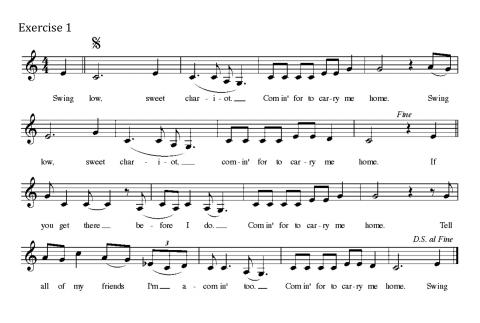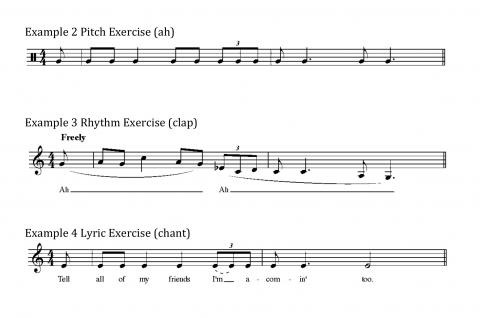Eliminating Vocal Mistakes

Vocalist/pianist Carolyn Wilkins is an associate professor in Berklee’s Ensemble Department. She has performed throughout North and South America and released four CDs. Visit www.carolynwilkins.com. This lesson was excerpted from her Berklee Press book Tips for Singers.
Matt Samolis
When I first began studying voice, I practiced by repeatedly singing a piece from beginning to end until I made a mistake. Then I would start again, vowing to sing the song correctly the next time. Instead, I would usually find myself repeating the same mistake with perhaps a few additional wrong notes. I would doggedly return to the beginning and sing the song again. When I got to the offending measure, I would still sing it incorrectly. A teacher of mine called this form of practice “perfecting your mistakes.”
In order to practice a piece of music effectively, you have to break it down and analyze the cause of your mistakes. Is the problem with the pitch? Is the problem in the rhythm? Is word pronunciation causing you to make a mistake? A thoughtful analysis of the problem can help you avoid similar mistakes in the future.
Troubleshooting
Have you ever heard someone singing along with his or her favorite song, thinking it was sounding great only to be exposed as hopelessly off key the instant the recording was turned off? Learning the melody of a song pitch by pitch without the original recording helps distinguish fact from fantasy where your singing is concerned. When you can sing a song a cappella and sound great, you know you’ve really got it.
Let’s suppose you are learning the classic African-American spiritual “Swing Low, Sweet Chariot” (see example 1). Let’s say that you have problems with the phrase at bar 13 “Tell all of my friends I’m a-comin’ too.” Every time you sing this section, you stumble on the same note. To determine whether your mistake comes from an incorrect understanding of the melody, start at the beginning of the phrase and sing the pitches without rhythm, using the syllable “ah” (see example 2). Singing the passage out in this fashion helps you focus on the flow of the melody. After you sing it through, check your pitch against the piano to ensure that you’ve sung the notes correctly.
If you breezed through the problem area by using this method, go back and sing the passage in time with the lyrics. If you can now sing it to your satisfaction, you may have fixed your mistake.
Practicing the Rhythm
If things still don’t sound right when you sing the passage, your problem may be rhythmic. Try counting out loud and clapping the rhythm of the problem passage (see example 3). This ensures that you understand how the rhythm should go when the song is stripped of its melody and lyrics. Next, return to the passage and sing it slowly, counting mentally as you sing. Make sure that its rhythm is the same as the rhythm you clapped. If the rhythm is correct but the passage still sounds wrong, there is another area to investigate.
Practicing the Lyrics
Sometimes a passage sounds fine on “ah” but, once lyrics are added, it falls apart. In these instances, I find it helpful to practice chanting the words on a single note, keeping my tongue and jaw as relaxed as possible. This method forces me to consider my breathing. Do I have enough air to get through each phrase? Where are the logical places to take a breath? How can I preserve the message of the song and still have enough air to get through the phrase?
Sometimes the problem is not in articulating the lyrics but in remembering them. I like to memorize lyrics by saying them as though I were speaking to a friend. Sometimes I practice saying them with different rhythms, as though they are lyrics of a rap song or a long run-on sentence.
A singer I know commits lyrics to memory by writing them out 10 times. If this method works for you, go for it. You can practice lyrics while you wash the dishes, do the laundry, whatever. The more deeply you can imprint the words in your brain, the better the odds that, under the stress of an important performance, you will sing them properly.
Intonation Problems
If you have worked on the above elements of your song and things still sound off-key, you need to work on intonation. Here are three areas to troubleshoot for intonation problems.
1. Inner hearing. Sometimes people sing out of tune because they do not have the correct pitch in their “mind’s ear.” Though they may have a rough idea of the shape of the phrase in question, their grasp of specific pitches is not sufficiently clear.
While seated at a piano, identify the problem note or notes and play them several times, allowing the piano tone to die away before you strike the key again. Next, sing the note in an unforced manner without dynamics or vocal expression. If the pitch is high and you can sing it easily in tune during a regular vocal warm-up, sing it an octave lower at first to avoid tiring yourself. The purpose here is to clearly get the sound of the pitch in your ear.
Once you can sing the problem note successfully, sing the passage a few notes before it in the same relaxed manner and out of tempo. Once you can sing this part of the passage in tune, continue to add notes until you have sung all notes in the phrase in tune and effortlessly.
2. Physical tension. Another common cause of intonation problems is physical tension. Practice the passage in question in front of a mirror. Do the tendons in your neck pop out? Does your face twist into a grimace? Do your shoulders hunch? We often sing out of tune in those sections of a song where we are most emotionally invested. Without being aware of it, we tighten up physically and mentally.
If you are habitually tense, do stretches or warm-up exercises at the beginning of your practice session. As you become more aware of your body, it becomes easier to notice and eliminate intonation problems caused by physical tension.
3. Breath management. As you sing the troublesome passage, monitor your breath. Do you squeeze out the tail end of the phrase with your last bit of air? Notes sung without full breath support have a tendency to be unstable. In the excitement of performance, it is easy to forget to fully support your tone, especially in long phrases. But if you consciously plan your breaths during practice time, you will be far more likely to stay on key during a concert.
Final Checklist
When you sing new material with a band for the first time, the full instrumentation can make even the most familiar melody sound different. Before your first run-through with the band, ask yourself these questions:
•Is the song in the best key for my voice?
•Have I mastered the song’s melody, rhythm, and lyrics and memorized them?
•Am I totally comfortable with the message, intent, and attitude of my song?
If you can honestly answer yes to these key questions, you are ready to go to a band rehearsal to prepare to sing your song before an audience.

Swing Low, Sweet Chariot




